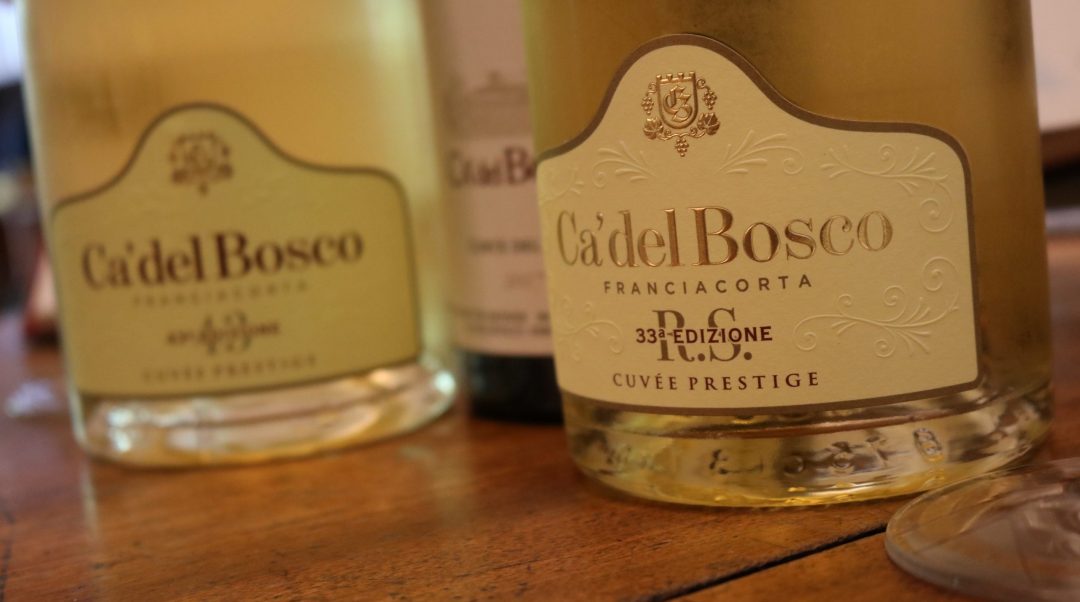The story of Ca’ del Bosco Franciacorta starts like this… In the mid-1960s, Annamaria Clementi Zanella purchased a little house in the heart of a chestnut forest. A decade later, her son Maurizio transformed the Ca’ del Bosco (house in the woods) into a state-of-the-art winery producing some of Italy’s top traditional method sparkling wines.
A Little Preamble on the Franciacorta Wine Region
The winemaking region of Franciacorta is situated in Lombardy, to the south of Lake Iseo, and east of Bergamo. The region’s vineyards span a glacial amphitheatre of rolling hills, forming a warm mesoclimate moderated by cooling breezes from the foothills of the Rhaetian Alps.
Franciacorta produces among the finest of Italian traditional method sparkling wines. Chardonnay is the star grape here, blended with Pinot Noir, and Pinot Blanc.
“Franciacorta is not a sparkling wine. In Italian legislation it is not classed as a spumante” explained Maurizio Zanella in a recent virtual tasting. “It is a wine that just happens to have bubbles” he added.
He went on to detail the vinous character, rounded structure, and broad mid-palate that sets Franciacorta apart from other traditional method wines. This is why the region generally produces wines with very little liqueur d’expedition. “We don’t need it”.
The Unique Production Methods of Ca’ del Bosco Franciacorta
Ca’ del Bosco was one of the pioneering forces behind the creation of the Franciacorta DOCG and establishment of its growers’ consortium. Right from the outset, Zanella pushed the appellation to adopt quality-focused measures like lowering grape yields and increasing minimum ageing time on lees.
Not content to follow traditional practices, Ca’ del Bosco devised a unique method to retain aromatic complexity and structural longevity in their wines. After manual harvest and strict grape sorting, Ca’ del Bosco treats their grapes to a spa day.
Grapes are washed in a series of three whirlpools to eliminate impurities. Once cleaned, the grapes are gently dried with cold air. This process eliminates the need for settling (clarification via sedimentation) after fermentation. It also greatly reduces the winery’s reliance on sulphur additions.
To further reduce sulphur inputs, Ca’ del Bosco has developed a strictly controlled oxygen-free process for vinification, bottling, and disgorging of its sparkling wines.
The Evolving Style of Ca’ del Bosco Franciacorta
One of Zanella’s major concerns in recent years has been sugar. Or more precisely, how to integrate it more naturally and reduce its overall use in his wines.
Six years ago, he stopped using cane sugar in his wines. Ca’ del Bosco Franciacorta is now dosed exclusively with organic grape concentrate. “I want my wines to be as natural as possible” said Zanella. “It just didn’t make sense to be introducing a foreign sugar source”.
Zanella and his team have also progressively lowered dosage levels. “We only have two sparkling wines left at four grams/litre (g/L). All our other Franciacortas are under two g/L”.
Another innovation dear to Ca’ del Bosco Franciacorta is the introduction of recently disgorged wines from their Cuvée Prestige, multi-vintage cuvée. Disgorged some ten years later, these limited edition wines are produced as a testament to the bottle ageing potential of the Ca’ del Bosco Franciacorta Cuvée Prestige.
Tasting Ca’ del Bosco Franciacorta Cuvée Prestige Wines
What does VW, PW, LW mean in my Ca’ del Bosco Franciacorta Tasting Notes ? Check out my wine scoring system.
Ca’ del Bosco Franciacorta Cuvée Prestige, 43 Edizione – 92pts. PW
The Cuvée Prestige is a multi-vintage bottling (referred to as non vintage in other regions), made with roughly 20% reserve wine. This is the 43rd edition of the estate’s flagship wine. It is a classic blend of three-quarters Chardonnay, with Pinot Noir and Pinot Blanc in supporting roles. The wine is aged for 25 months on lees, and is dosed to just 2 g/L.
Inviting aromas of lemon, shortbread biscuits, hazelnut, and yellow orchard fruit feature on the nose. The palate is fresh and medium in weight, with a rounded structure and fine, supple bubbles. Subtle apricot notes join the aromatic chorus on the palate, giving way to a dry, smooth finish.
Where to Buy: SAQ ($44.75), LCBO ($44.95)
Ca’ del Bosco Franciacorta Cuvée Prestige, 33 Edizione – 93pts. PW
Produced ten years ago, a small batch of the 33 Edizione Cuvée Prestige was held back and only disgorged in late 2020. Blend components and dosage levels were similar to the 43 edition cuvée.
Intense aromas of buttered toast, dried lemon peel, and roasted hazelnut leap from the glass. The palate is lively and fresh, with ultra-fine bubbles, and a broad, creamy mid-palate. Deep nutty, savoury flavours linger on the long, dry finish.
Where to Buy: Enquire with agent, Montalvin (Québec) or Galleon Wines (Ontario)
Comparative Notes: 43 Edizione vs. Recently Disgorged 33 Edizione
Both wines are well-crafted examples of how good traditional method sparkling wines from Franciacorta can be. The more youthful 43rd edition will appeal more to those that like a fresh, fruit-focused, lively style of sparkling wine. Whereas, the 33rd edition is deeper and more savoury, with quite subtle mousse, and a seemingly drier finish.
As an aperitif wine, the 43rd edition would be my pick. The dry, savoury, quite vinous nature of the 33rd calls out for a similarly hearty food pairing. Dishes featuring earthy root vegetables of mushrooms should work well.

